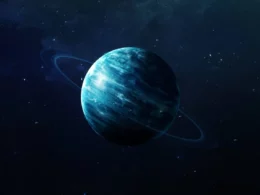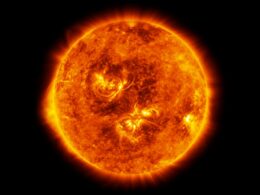Mars, also known as the Red Planet, has been a topic of interest for scientists and space enthusiasts for decades. One of the many intriguing aspects of Mars is its day length. So, how long is a day on Mars?
Unlike Earth, which takes approximately 24 hours to complete one rotation, Mars takes slightly longer. A day on Mars, also known as a sol, is 24 hours and 39 minutes long. This means that Mars has a slightly longer day than Earth.
Mars is the fourth planet from the sun and is part of our solar system. It is often referred to as the Red Planet because of its reddish appearance caused by iron oxide, or rust, on its surface. While Mars is similar to Earth in many ways, it has a number of unique characteristics that make it an interesting subject of study. Understanding the length of a day on Mars is just one piece of the puzzle when it comes to learning more about this fascinating planet.
Martian Solar Day and Year
Length of a Day on Mars
A day on Mars, also known as a “sol,” is slightly longer than a day on Earth. According to NASA, the average duration of a Martian day is 24 hours, 39 minutes, and 35.244 seconds. This is just over 2% longer than a day on Earth. The length of a day on Mars is determined by its rotation on its axis.
The sidereal rotational period of Mars is 24 hours, 36 minutes, and 22.66 seconds, according to the same source. This is the time it takes for Mars to complete one full rotation relative to the fixed stars in the sky.
Martian Solar Cycle
A Martian year, also known as a “Martian solar cycle,” is the time it takes for Mars to complete one orbit around the sun. According to NASA, a Martian year is approximately 687 Earth days long. This means that a Martian year is about 1.88 times longer than a year on Earth.
One interesting fact about the Martian solar cycle is that it is responsible for the planet’s seasons. Mars has four seasons, just like Earth, but they are longer due to the longer year. The seasons on Mars are caused by the planet’s axial tilt, which is similar to Earth’s. However, the tilt is more extreme on Mars, which leads to more extreme seasons.
In summary, a day on Mars is slightly longer than a day on Earth, and a Martian year is approximately 1.88 times longer than a year on Earth. The Martian solar cycle is responsible for the planet’s seasons, which are more extreme than those on Earth due to the planet’s axial tilt.
Physical Characteristics of Mars

Mars is the fourth planet from the Sun and is often referred to as the “Red Planet” due to its reddish appearance. It has a number of unique physical characteristics that make it different from other planets in the solar system.
Mars’ Atmosphere and Weather
Mars has a thin atmosphere that is composed mainly of carbon dioxide. The atmospheric pressure is about 1% of Earth’s atmospheric pressure at sea level. The thin atmosphere means that Mars experiences extreme temperature changes. During the day, temperatures can reach up to 70 degrees Fahrenheit (20 degrees Celsius), but at night, temperatures can drop to as low as -100 degrees Fahrenheit (-73 degrees Celsius).
Mars also experiences dust storms, which can last for months and cover the entire planet. These dust storms can have a significant impact on the planet’s weather patterns and can even affect the solar panels on spacecraft.
Geological Features
Mars has a number of unique geological features, including the largest volcano in the solar system, Olympus Mons. It also has a massive canyon system called Valles Marineris, which is over 2,500 miles (4,000 kilometers) long and up to 4 miles (7 kilometers) deep.
The planet’s surface is covered in regolith, which is a layer of loose, fragmented material that covers solid rock. This regolith is made up of a mixture of dust, rocks, and other materials.
Mars’ Moons and Orbit
Mars has two small moons, Phobos and Deimos. These moons are irregularly shaped and are believed to be captured asteroids. They orbit Mars at a relatively close distance, and their orbits are slowly decaying, which means that they will eventually crash into the planet’s surface.
Mars has a relatively elliptical orbit around the Sun, which means that its distance from the Sun varies throughout the year. At its closest approach, Mars is about 34 million miles (55 million kilometers) from the Sun, while at its farthest point, it is about 154 million miles (249 million kilometers) away.
Overall, Mars is a fascinating planet with a number of unique physical characteristics that make it an interesting subject of study for scientists and researchers.
Frequently Asked Questions
What is the duration of a Martian sol compared to an Earth day?
A Martian sol, which is a day on Mars, is slightly longer than an Earth day. According to Royal Museums Greenwich, a Martian sol lasts 24 hours, 39 minutes, and 35 seconds, while an Earth day lasts 24 hours. This means that a Martian sol is approximately 39 minutes and 35 seconds longer than an Earth day.
What is the length of a day on Mars’s moons, Phobos and Deimos?
Mars has two small moons, Phobos and Deimos, which have very short rotation periods. According to NASA Mars, Phobos takes only 7 hours and 39 minutes to complete one rotation, while Deimos takes 30 hours and 18 minutes. This means that a day on Phobos is less than one-third of an Earth day, while a day on Deimos is slightly longer than an Earth day.
In terms of rotation, how does Mars compare to the other planets in the solar system?
Mars has a rotation period that is similar to that of Earth. According to Space Centre, Mars takes 24 hours, 37 minutes, and 22.7 seconds to complete one rotation on its axis. This is slightly longer than an Earth day, which takes 24 hours to complete one rotation. In comparison, some planets in the solar system have much shorter or longer rotation periods. For example, Jupiter has a rotation period of only 9 hours and 55 minutes, while Venus takes 243 Earth days to complete one rotation.





